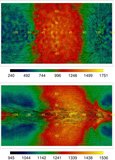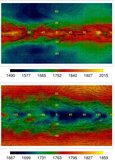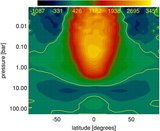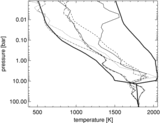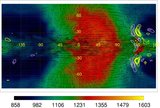Image Details

Caption: Figure 4.
Logarithm (log 10) of the total wind kinetic energy (in joules) in each layer of the model atmosphere as a function of atmospheric depth and planet day in the run. The kinetic energy at each level is calculated as the horizontal integral of ρ v 2 H /2, where ρ is the density and v H is the horizontal wind speed. The atmosphere starts at rest but it quickly develops a transonic flow. The equatorial jet shown in Figure 3 contains most of the kinetic energy of the atmosphere. The inert layers below 10 bar slowly gain kinetic energy by exchange with the radiatively forced layers above, and they have yet to reach a stationary state by the end of the run.
Copyright and Terms & Conditions
© 2010. The American Astronomical Society. All rights reserved.


